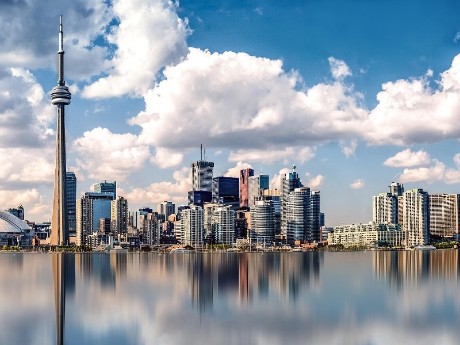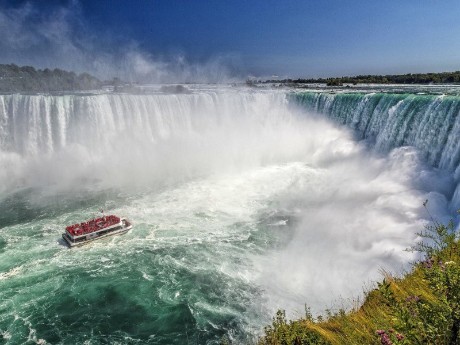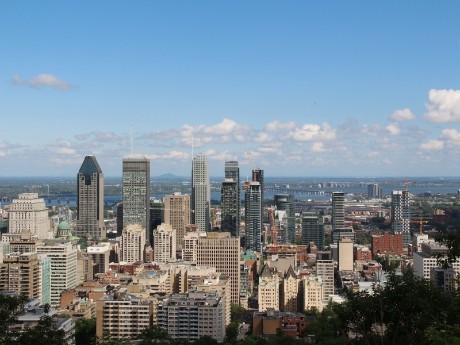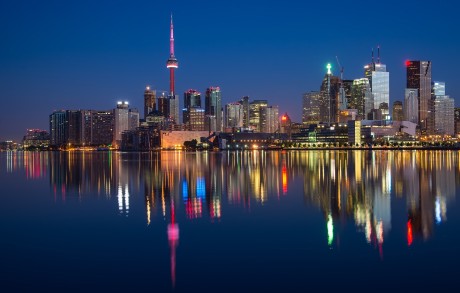Ontario & Quebec Highlights: Toronto, Niagara Falls & Montreal
This trip highlights Ontario and Quebec’s must sees! In Ontario, visit the CN Tower, once the tallest building in the world and the world's largest waterfalls, Niagara Falls. A night sound and light show at the falls is spectacular. While in the area, a 30 minute drive to the World Heritage Town of Niagara on the Lake is a must and if you are a wine buff, there are many wineries in the Niagara region for your wine tasting buds. Move on to your next destination of world class, Montreal.
Read more
This trip highlights Ontario and Quebec’s must sees! In Ontario, visit the CN Tower, once the tallest building in the world and the world's largest waterfalls, Niagara Falls. A night sound and light show at the falls is spectacular. While in the area, a 30 minute drive to the World Heritage Town of Niagara on the Lake is a must and if you are a wine buff, there are many wineries in the Niagara region for your wine tasting buds. Move on to your next destination of world class, Montreal. In Montreal, there are botanical gardens and underground cities to discover as well as the Vieux Port and its many attractions including the vantage city views from the Montreal Eye. If you make it to Quebec City, sign up for a whale watching tour and don't forget to visit nearby Montmorency Falls, a truly spectacular site. A 30 minute drive from Quebec City, lies Wendake, a thriving indigenous community with its own museum, displaying the rich cultural heritage of the indigenous community. This trip lets you experience some of Canada's best cities, rich culture, vibrant nightlife and more. Waterviews strives to offer accommodation options within walking distance of water and/or in an area of touristic interest. Our prices include taxes (but excludes local tourist taxes). Customize your trip to your personal preferences with optional activities (hit the “Add Activities’’) or change hotels, etc. Contact us for customization at no extra cost at: Service@waterviewstravel.com
Destinations
- Toronto
- Niagara Falls (Ontario)
- Montreal
Itinerary
Toronto

Visitors to Toronto are welcomed by its diverse population with famed Canadian friendliness and hospitality. Set along Lake Ontario’s Northern Shore, the city has something to offer for everyone and is home to countless restaurants, lively nightlife and a large cultural scene with theatre, art galleries and museums. Despite its big city status, Toronto offers a safe and peaceful environment as well as many green spaces and parks within its centre.
Read more
Visitors to Toronto are welcomed by its diverse population with famed Canadian friendliness and hospitality. Set along Lake Ontario’s Northern Shore, the city has something to offer for everyone and is home to countless restaurants, lively nightlife and a large cultural scene with theatre, art galleries and museums. Despite its big city status, Toronto offers a safe and peaceful environment as well as many green spaces and parks within its centre.
Additional Information
In 1998, the cities of Toronto, Scarborough, North York, Etobicoke, and York and the Borough of East York amalgamated to form the current City of Toronto. This is also known as Metropolitan Toronto; "the 416" after its area code (although now there are some new area codes, the overwhelming number of landline phone numbers in the Toronto area are still "416"); or more recently "the 6" (representing both the area code and the six cities involved in the amalgamation), and has a population of over 2.6 million people. More than half of these were born in some country other than Canada: a fact obvious to any visitor immediately, as the city has many vibrant bustling neighbourhoods with street signs in several languages.
Toronto and its surrounding suburbs are collectively known as the Greater Toronto Area (GTA). Outlying suburbs are also known as "the 905" after their area code, although this code is also used in the Hamilton and the Niagara Region, stretching from Cobourg and Colborne in the east to the border in Niagara Falls to the southwest. The entire area including Toronto is known as the "Golden Horseshoe" and has a population of over 8 million people. Distances between cities in the area can be great as it sprawls along, outward and even wraps around the western end of Lake Ontario; public transit is not always effective enough to make it a quick or seamless trip. Many suburban residents rely on private cars to get around.
A popular urban myth has it that the United Nations rated Toronto as "the most multicultural city in the world". While the UN and its agencies are not in the habit of rating cities, it remains a fact that Canada is a nation of immigrants, and Toronto demonstrates this abundantly. A UN agency lists Toronto as second only to Miami as the city with the most foreign-born residents, but Toronto's residents represent far more cultural and language groups, which is arguably a better measure of multi-culturalism. Most immigrants either pass through Toronto on their way to other parts of the country or stay in Toronto permanently. Many people born abroad consider themselves Canadian as much as native-born Canadians and will be offended if treated otherwise. This contributes to the overall cultural mosaic that is Toronto today. Within Toronto, most ethnic groups will work their way into the fabric of Canadian society but some still retain their distinct ways such as language, dress (if only for special occasions), customs, and food.
As a result of this cultural mosaic, Toronto is home to many ethnic festivals throughout the year. Toronto also has several radio stations that broadcast in various languages, and two multilingual television channels. The City of Toronto officially deals in 16 different languages while the Toronto Transit Commission (public transit) has a helpline that deals in 70 languages. Even large department stores such as The Bay in downtown Toronto proudly advertise service in 9 languages. The lingua franca of Toronto, however, remains English.
Climate
Toronto's climate is on the whole on the cool side, and variable conditions can be expected. Come prepared for winter: winters are cold (temperatures average -3.8°C (25°F) in January), mostly cloudy, at times snowy and uncomfortably windy. However, the type of extreme cold experienced further north in Canada usually lasts for no more than a couple of days at a time. The city experiences warm and humid summers with an average high of 27°C (80°F) and a low of 18°C (65°F) in July/August with many muggy evenings but rarely extreme heat. On average, the temperature exceeds 30°C (86°F) only 12 days per year, but hotter air masses often arrive with moderately high humidity levels. Late spring/early summer and early fall are generally considered to be the best times to visit for weather and less crowds, mid-summer is the peak tourist season, but visitors will find that Toronto's vibrancy extends through the winter with outdoor skating rinks and bundled up club-goers, etc. Toronto's public buildings are nearly all air-conditioned and fully heated.
Sometimes during the winter, severe storms can slow down transportation and activities in the city for a day or two. In the summer, thunderstorms occur from time to time, most lasting less than an hour.
Areas closer to the downtown core are generally 1 to 1.5°C warmer in winter due to the urban heat island effect. For the rest of the year, areas close to Lake Ontario are warmer by about 1°C due to the moderating effects of the lake. This is especially prominent in March and November when the city receives rain while areas just north of the city receive snow.
Visitor information
© Sourced from Wikivoyage
Niagara Falls (Ontario)

An unstoppable flow of rushing water surges over the arcing fault in the riverbed with thunderous force. Great plumes of icy mist rise for hundreds of meters as the waters collide, like an ethereal veil concealing the vast rift behind the torrent. Thousands of onlookers delight in the spectacle every day, drawn by the force of the current and the hypnotic mist.
Read more
An unstoppable flow of rushing water surges over the arcing fault in the riverbed with thunderous force. Great plumes of icy mist rise for hundreds of meters as the waters collide, like an ethereal veil concealing the vast rift behind the torrent. Thousands of onlookers delight in the spectacle every day, drawn by the force of the current and the hypnotic mist.
Additional Information
Niagara Falls was incorporated on June 12, 1903. Its population was 88,000 in 2016.
Mainly a tourist destination, the main attraction has always been Niagara Falls, which brings hundreds of thousands of tourists to the city. Tourism plays a major part in the economy of the region. Increasingly, visitors seeking more natural settings are finding the Niagara River to a great place to hike and visit downstream from the Falls where the majority of visitors go.
Visitor Welcome Centres open daily at 9AM, June through August. They offer advice and maps of the area, and sell People Mover bus tickets and the Great Gorge Adventure Pass. They are located at: Table Rock Centre (inside the mall near the brink of the Horseshoe Falls) Maid of the Mist (outside the Maid of the Mist ticket booths) Clifton Hill (at the intersection of Clifton Hill and Falls Avenue) Clifton Hill District (top of Clifton Hill Victoria Avenue area) Murray Street (near Queen Victoria Place, below the Fallsview Tourist Area and Fallsview Casino Resort)
Climate
Spring: Temperatures range from 5° to 19°C (41°-66°F). Nightly temperatures range from -3° to 8° C (26° to 46°F). As temperature changes are sudden outdoor camping before mid-May is not advisable.
Summer: In June, July & August the weather is generally bright and sunny with sporadic rainfall. Storms are caused by Lake Erie and Lake Ontario and are seldom severe.
Fall: In the fall, it is unlikely to snow prior to the end of October. First killing frost and/or snowfall be expected by late October or early November. Mixed weather patterns prevail. Rain and cloudy skies are common.
Winter: The days are generally cold and clear. Snow is moderate. Snow storms are infrequent. Lake effect snowfalls are mainly localized to areas near Buffalo and southward. Lake Erie, during extended cold weather will freeze over completely. Some of the activities associated with the falls (e.g. Maid of the Mist and Marineland) do not run during winter due to the frozen conditions, but most attractions now remain open year-round, dealing with mist-related ice near Niagara Falls.
© Sourced from Wikivoyage
Montreal

Montreal may not be the political centre of Quebec, but it certainly is the region’s cultural heart. Boasting itself as one of the most diverse cities of North America, French speaking Montreal dazzles with its architecture, frequent festivals and an excellent music scene. However, nothing is as persuading as the first-class gastronomy, which includes top-notch patisseries and cafés and outstanding restaurants and bars with an endless supply of local and international dishes.
Read more
Montreal may not be the political centre of Quebec, but it certainly is the region’s cultural heart. Boasting itself as one of the most diverse cities of North America, French speaking Montreal dazzles with its architecture, frequent festivals and an excellent music scene. However, nothing is as persuading as the first-class gastronomy, which includes top-notch patisseries and cafés and outstanding restaurants and bars with an endless supply of local and international dishes.
Additional Information
On an island in the St. Lawrence River at the historically highest navigable point, Montreal has been a strategic location since before the arrival of Europeans in Canada. A thriving Iroquoian town called Hochelaga was on the site of present-day Montreal when explorer Jacques Cartier first visited in 1535. In 1642, the tiny town of Ville-Marie was founded as a Catholic mission by Paul Chomedey, sieur de Maisonneuve. It soon became a centre of the fur trade. After its capture by the English in 1762, Montreal remained (until the 1970s) the most important city in Canada and was briefly capital of the province in the 1840s.
Prohibition on sales of alcohol in the United States during the 1920s and 1930s made Montreal a Mecca for cross-border fun seekers from nearby New England and New York. The city built up a seedy, yet playful, industry in alcohol, burlesque, and other vices. In the 1960s, an urban renewal drive centred on Expo 67. The World's Fair in Montreal brought a subway system (the métro) and attractive urban parks and is considered to be one of the most successful World Fairs. Over 50 million visitors gathered in Montreal during this memorable summer. The 1976 Olympics left a strikingly idiosyncratic stadium and many other urban improvements.
The opening of the Saint Lawrence Seaway in 1959, though much-lauded as an economic boom, spelled the beginning of the end for Montreal's economic dominance in Canada. Once the transition point between western railways and eastern sea carriers, Montreal watched helplessly as some of this business moved farther west, up the now navigable seaway, to ports in Ontario and on Lake Superior. The Quebec sovereignty movement, which began to pick up steam in the 1960s, further chilled the atmosphere for Canada-wide businesses, many of which moved their headquarters to Toronto.
Following an economic depression in the 1980s and 1990s, Montreal became more secure in its place in North America and the world. It remains a centre of culture, arts, computer technology, aerospace, the biotech industry, and media for all of Canada.
Orientation
It has been said that Montréal is the only city in the world where the sun "rises in the south".
Montrealers use an unconventional compass, using the river and the mountain as cardinal points. When you are downtown, the St Lawrence River is “south” and Mount Royal is “north”; making the West Island and the East End correct in both their names and orientations. This tends to confuse visitors because the “East” End is really north and the “South” Shore is east, and the St Lawrence River runs almost north-south at this location.
Most local maps use this convention as do the highways around the city. For example, Autoroute 15 north actually runs northwest and Autoroute 40 east runs northeast.
To underscore this fact, a Montreal map will show that the "south end" of Victoria Bridge is in fact further north than the "north end".
Gay Montreal
Montreal is an extremely inviting destination for gay and lesbian tourists. Canada's contributions to gay rights have become widely known, but Quebec was the first province in Canada to pass a non-discrimination law for sexual orientation and to provide same-sex civil unions (although Toronto was the first municipality in Canada to do so). Same-sex marriage is legal in Quebec (neither residency nor citizenship are required for a marriage licence, but there is a three-week waiting period after you receive the licence) as it is in the rest of Canada. Canadian and Quebec immigration law allow residents to sponsor their same-sex partners or spouses.
Montreal is a very safe, open, and inviting city. The métro station in the Gay Village, Beaudry, is marked with rainbow pillars. Divers/Cité Montreal's pride celebration (last week of July, first week of August) is the second-largest in Canada after Toronto's.
Climate
The climate of Montreal is a true humid continental climate with 4 distinct seasons. The city has warm—and occasionally hot & humid—summers, generally mild spring and autumn, and often very cold & snowy winters. Montreal gets over 2,000 hours of sunshine annually. Precipitation is moderate throughout the year, with around 2 metres of snow per season.
Visitor information
© Sourced from Wikivoyage





